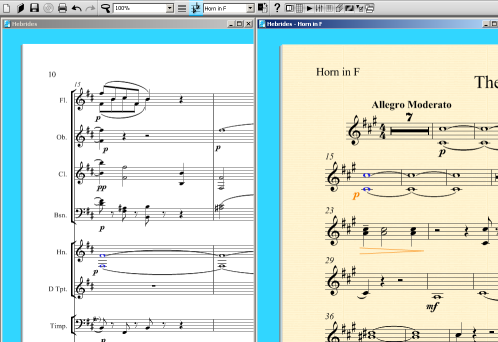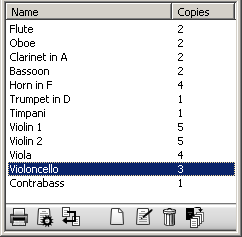Dynamic Parts™ in Sibelius
Parts in other programs
In other programs, to get instrumental parts you have to ‘extract' them from the full score. You then have to spend time checking them and cleaning them up. And if you make revisions to the score later - which almost always happens in practice - you either have to spend ages making the same revisions in the parts yourself, or extract them all over again.
Not so in Sibelius.
Dynamic Parts
Sibelius has a unique feature called Dynamic Parts. You don't have to extract them – in fact, you don't have to do anything to get parts! As soon as you start a new score, all the parts are already there – and you can look at any of them from a list on the toolbar.

Editing the full score (left) automatically changes the part (right)
As you add music to the full score, it appears in the relevant parts too. In fact, whatever you do to the score, Sibelius instantly updates the parts. Or you can even write music in the parts, and the score will change to match! But you can also change things in parts without affecting the score if you like, such as adding cues.
The parts are transposed if necessary, have bar rests grouped into ‘multirests', and include all the relevant markings such as time signature and tempo changes. So you don't have to think about anything.
![]() Watch movie: Dynamic Parts »
Watch movie: Dynamic Parts »
Create cues instantly
Creating cues in parts is now the work of a moment. Simply copy the music you want to appear in the cue, and choose Paste As Cue. Sibelius 5 does the rest for you – it makes the cue small, puts it in a suitable voice, transposes it or changes clef as necessary, deletes dynamics and articulations (optional), adds a text label, hides the cue in the score, and stops it playing back. You can even add a cue to multiple instruments at once.
What’s more, there are two new plug-ins to make cueing even easier. Suggest Cue Locations suggests suitable points for cues in your score, based on either the number of bars rest or the duration of a rest in a part, while Check Cues verifies that cues you’ve previously added are still correct, in case you’ve changed the music.

Paste As Cue makes creating cues the work of a moment – Sibelius automatically makes the music small and stops it playing back.
Customize cue appearance
Sibelius 5 does the work of creating cues for you, but you still have complete control over how they appear. You can choose whether you want articulations and dynamics to be included, and whether you want the cue to have new clefs and octave lines or be transposed to an appropriate pitch for the destination instrument.
Easy instrument changes
Scores often have two or more instruments played by the same person, such as percussion, or clarinet doubling saxophone. Or sometimes you need to rewrite a whole part for a different instrument. Now Sibelius will do this automatically for you: simply put an instrument change anywhere in the music, and Sibelius 5 will change the instrument from that point onwards – altering its name, clef, sound, even the transposition and staff type if necessary.
Plus, if you write for unusual instruments you can now design your own, choosing the name, clef, range, sound, etc. you want. From glockenrimba to trumpet in F#, your imagination is the only limit!

Easy instrument change: Sibelius automatically transposes the music and changes the sound used for playback.
Auto Layout™
Sibelius also takes care of the layout of parts for you. It puts page turns at convenient places, and positions rehearsal marks, new sections, key changes etc. at the start of systems, to make them easier for players to locate. In fact, you'll hardly need to adjust parts at all – just a quick look through and then print.
You can print a complete set of parts with one click of the mouse, and even specify how many copies you want for each instrument.

Print a complete set of parts with one click
Overall, Dynamic Parts will save you many hours of work on every score – all the time spent writing out or extracting parts is now a thing of the past.
Quick links
Sibelius features »
What's new »
Sibelius FAQ »
Education case studies »
Download demo »
Buy/upgrade »
Take a tour
A comprehensive guide to Sibelius's features

